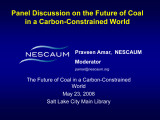TO
Filters: Collection: "ir_eua" Subject: "CO2"
1 - 25 of 10
| Title | Date | Subject | Description | ||
|---|---|---|---|---|---|
| 1 |
 |
Accelerating deployment of retrofitable CO2 capture technologies through predictivity: (Simulation, verification, validation / uncertainty quantification) - 2010 Annual report (for year 1 of 3) to DOE NNSA from The University of Utah | 2011 | CO2; CO2 capture technologies; predictivity; fossil-fuel utilization | There is an ever increasing national awareness that an effective, sustainable energy future must include fossil-fuel utilization that deploys cost-efficient technologies (both new and retrofit) that significantly improve energy efficiencies and reduce CO2 emissions over existing electric power and t... |
| 2 |
 |
Basin oriented strategies for CO2 enhanced oil recovery: Alaska | 2005-04 | Alaska; North Slope; Cook Inlet; Oil; Gas; Oil recovery; EOR; CO2; Carbon dioxide; Oil fields; Oil production industry | The oil and gas producing regions of Alaska have nearly 45 billion barrels of oil which will be left in the ground, or "stranded", following the use of today's oil recovery practices. A major portion of this "stranded oil" is in reservoirs technically and economically amenable to enhanced oil recove... |
| 3 |
 |
Basin oriented strategies for CO2 enhanced oil recovery: Rocky Mountain Region | 2006-02 | Rocky Mountain; Colorado; Utah; Wyoming; Oil; Gas; Enhanced oil recovery; EOR; CO2; Carbon dioxide injection; Oil fields; Basin oriented strategies; Domestic oil production | The Rocky Mountain oil and gas producing region of Colorado, Utah and Wyoming has an original oil endowment of nearly 34 billion barrels. Of this, 11 billion barrels (33%) has been produced or proven. As such, nearly 23 billion barrels of oil will be left in the ground, or "stranded", following the ... |
| 4 |
 |
Carbon dioxide sequestration: Effect of the presence of sulfur dioxide on the mineralogical reactions and on the injectivity of CO2+SO2 mixtures | 2010-01 | Carbon dioxide sequestration; CO2; Sequestration stream; Gas injection; CO2+SO2 mixture; Brine; Arkose; Calcite; Anhydrite; Calcium carbonate; CaCO3; Ankerite; Absolute permeabilities; Free-gas; Dissolved gas distribution; Saline formation; Contaminant gases; sulfur dioxide; SO2; Hydrogen sulfide; H... | This report presents experimental and modeling data on certain aspects of carbon dioxide (CO2) sequestration. As different processes are developed and implemented to facilitate the capture of CO2, other contaminant gases (sulfur dioxide, hydrogen sulfide and ammonia) may be present in the sequestrat... |
| 5 |
 |
Chemical looping combustion reactions and systems: Task 5 topical report | 2011-08 | Chemical looping combustion; CLC; Fuel combustion; CO2 capture; Electric power; Sequestration; FBR; CLOU; Thermogravimetric analysis; CO2; Carbon dioxide | Chemical Looping Combustion (CLC) is one promising fuel-combustion technology, which can facilitate economic CO2 capture in coal-fired power plants. It employs the oxidation/reduction characteristics of a metal, or oxygen carrier, and its oxide, the oxidizing gas (typically air) and the fuel source ... |
| 6 |
 |
Climate change 2007: The physical science basis--summary for policymakers | 2007-02 | Climate change; Greenhouse gases; Aerosols; Solar radiation; Radiative forcing; Third Assessment Report; TAR; Solar activity; Carbon dioxide; CO2; Methane; CH4; Nitrous oxide; N2O; Fossil Fuel; Land use; Agriculture; Land surface properties; Warming; Melting of snow and ice; Rising seal level; Globa... | The Working Group I contribution to the IPCC Fourth Assessment Report describes progress in understanding of the human and natural drivers of climate change1, observed climate change, climate processes and attribution, and estimates of projected future climate change. It builds upon past IPCC assess... |
| 7 |
 |
Climate change--current understanding and implications | 2008-05-23 | Global warming; Climate change; Coal; CO2; Carbon dioxide; Temperature; Radiative Forcing; Emissions; Greenhouse gases; Arctic warming; Sea level rise; Fossil fuel; Renewable | Four Primary Questions: 1-Is global warming (climate change) occurring? 2-What is the cause? 3-What will be the consequences? 4-What can/should we do? |
| 8 |
 |
Effects of partial pressure of oxygen on the stability of axial, oxy-coal, turbulent diffusion flames: Topical report task 8 | 2009-07-31 | Oxy-fuel combustion; Pulverized coal; Flue gas recirculation; CO2 sequestration; Near-burner zone environment; O2; CO2; Partial pressure of oxygen; Flame stability; Air combustion; Coal-jet ignition models; Predicting flame attachment; Retrofit; Oxy-coal combustion; Type 0 axial flames; Turbulent di... | Oxy-fuel combustion of pulverized coal with flue gas recirculation is potentially one of the few technologies that may allow CO2 sequestration technologies to be applied to existing coal-fired boilers. One issue of interest is to understand and predict the effects of the near-burner zone environment... |
| 9 |
 |
Panel discussion on the Future of Coal in a Carbon-Constrained World: Panel discussion slides | 2008-05-23 | future of coal; pannel discussion; CO2; carbon; assessment report | Slides that accompanied the panel discussion for The Future of Coal in a Carbon-Constrained World conference, May 23, 2008, Salt Lake City, Utah. |
| 10 |
 |
Technical challenges to geological carbon sequestration | 2008-05-23 | carbon sequestration; reduce CO2 emissions; geological carbon sequestration; CO2; CCS economics; CCS. | Conclusions: 1-Current knowledge strongly supports carbon sequestration as a successful technology to dramatically reduce CO2emissions. 2-Current science and technology gaps appear resolvable at scale Deployment issues, including regulatory, legal, and operational concerns can be advised by science ... |
1 - 25 of 10
